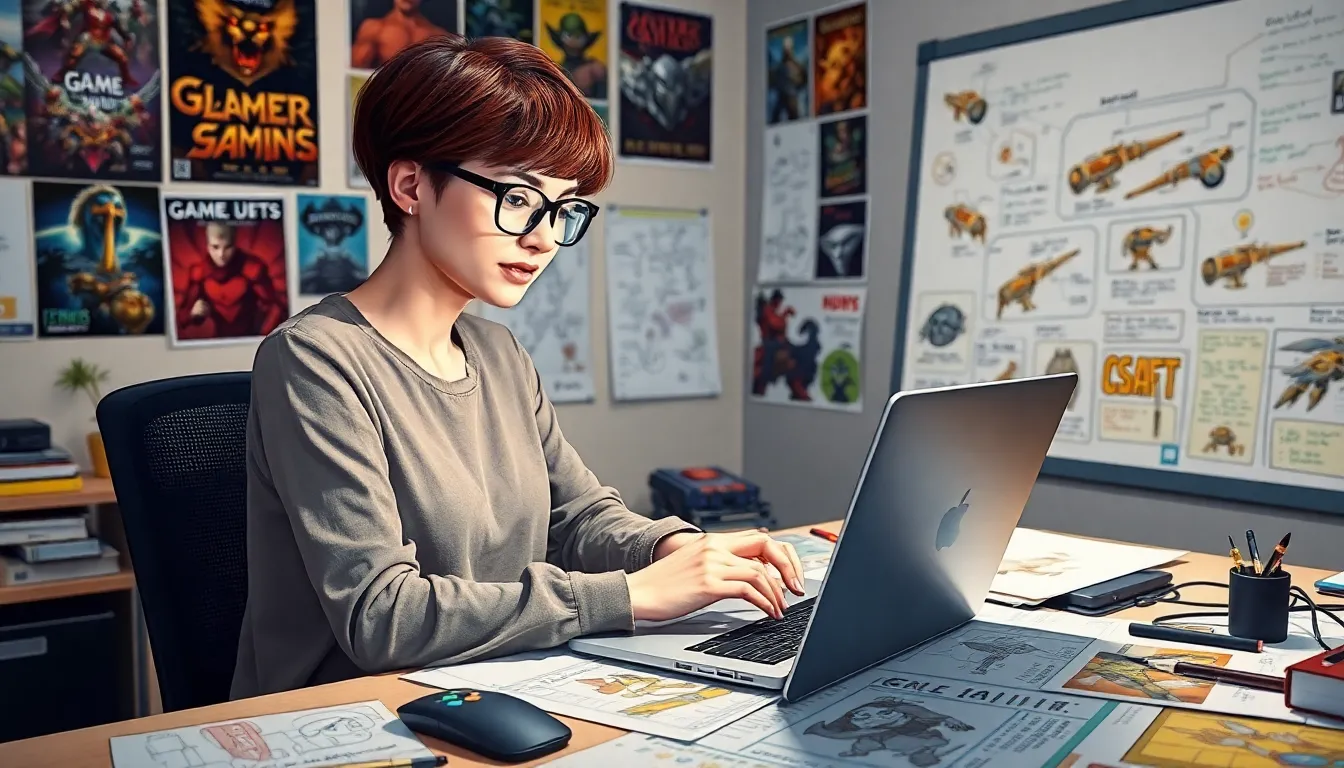Creating your own game isn’t just a dream reserved for tech wizards and coding ninjas. It’s an adventure waiting for anyone with a spark of imagination and a dash of determination. Whether you envision a thrilling quest through enchanted forests or a quirky puzzle that makes players scratch their heads, the possibilities are endless.
How To Create Your Own Game
Creating a game begins with understanding its foundational elements. Knowledge of game development encompasses various skills and concepts crucial for success.
The Basics of Game Design
Game design focuses on the user experience and gameplay mechanics. Crafting a compelling story engages players, while intuitive controls enhance interaction. Objectives, rules, and challenges contribute to gameplay. Balancing these elements can create an immersive experience. Additionally, prototyping allows designers to test ideas quickly and refine them based on feedback.
Different Game Genres
Game genres define the gameplay experience and appeal to diverse audiences. Action games prioritize fast-paced gameplay and reflex-based mechanics. Role-playing games emphasize character development and narrative depth. Puzzle games challenge players with problem-solving tasks, while simulation games replicate real-world activities. Understanding these genres helps creators target specific player preferences and inform design choices.
Planning Your Game

Planning serves as the foundation for a successful game development journey. This phase involves defining concepts and creating a design document to outline the game’s vision.
Defining Your Concept
Identifying the core idea initiates the game development process. Genres, such as action, puzzle, or simulation, help narrow down the focus. Establishing the primary goal keeps players engaged and motivated. Unique characters, settings, and storylines enhance the game’s appeal and differentiate it from others. Developing a preliminary game title brings clarity to the concept. Developers often reflect on player experiences during this stage, ensuring the concept resonates with the intended audience.
Creating a Game Design Document
Drafting a game design document (GDD) becomes essential for organizing ideas and expectations. This document typically includes game mechanics, visuals, audio, and target platforms. Including sketches or concept art provides a visual guide for the development team. Game mechanics, such as controls and rules, define player interactions. Establishing a timeline for milestones aids in maintaining project progress and accountability. Regular updates to the GDD accommodate changes and enhancements throughout development, promoting alignment among team members.
Choosing the Right Tools
Selecting the appropriate tools is crucial for creating a game that meets the vision and goals. Numerous options exist to cater to various needs during the development process.
Game Development Software Options
Game engines like Unity and Unreal Engine dominate the development landscape. Unity offers flexibility for 2D and 3D games and features an extensive asset store. Unreal Engine excels in high-quality graphics and complex environments, making it ideal for visually stunning adventures. For beginners, tools like GameMaker Studio and Construct provide user-friendly interfaces and drag-and-drop functionality, streamlining the development process. Moreover, Godot is open-source, allowing developers to customize their projects at no cost. Each software option presents unique benefits that developers can leverage based on their skills and project requirements.
Graphic and Sound Design Tools
Graphic design tools play a vital role in shaping a game’s visual identity. Adobe Photoshop and Illustrator are popular for creating detailed character designs and environments. Additionally, tools like GIMP and Inkscape offer powerful features without cost. For sound design, software such as Audacity and FL Studio allows for recording and mixing audio effects and music tracks. They cater to both beginners and professionals. Incorporating tools like Aseprite aids in pixel art creation, emphasizing unique visual styles. Using the right design tools enhances the overall player experience and ensures the game captures its intended aesthetic.
Building Your Game
Creating a game involves thoughtful execution of various components. Each phase contributes to the overall success of the project.
Prototyping Your Ideas
Prototyping turns concepts into tangible experiences. It allows creators to test core gameplay mechanics before full development. A basic prototype may be as simple as paper sketches or digital mock-ups. These early models provide insights into how players interact with game elements. Feedback from testers helps refine ideas and reveals what resonates. Iterating on prototypes leads to improvements and stronger game mechanics. The focus should remain on essential features that define the game experience.
Programming Fundamentals
Programming serves as the backbone of any game. Understanding basic coding principles is crucial for developers, regardless of experience level. Familiarity with languages like C# or C++ opens doors to many game engines. Beginners benefit from visual scripting offered by tools such as Unreal Engine’s Blueprints. With intuitive visual designs, programmers can implement logic without heavy coding. Simple projects help build foundational skills and confidence. Developers often learn to manipulate objects, control player movement, and respond to inputs. Strong programming skills lead to more polished and engaging gameplay experiences.
Testing and Feedback
Testing is vital in game development. It ensures the game runs smoothly and meets players’ expectations.
Importance of Playtesting
Playtesting serves as a critical phase in the development process. Engaging real players offers invaluable insights, highlighting areas for improvement. Identifying bugs early enhances overall gameplay quality. Observing how players interact with the game can reveal design flaws and areas needing adjustment. Based on their experiences, developers can refine mechanics and enhance user experience, ultimately leading to a more polished final product.
Gathering and Implementing Feedback
Feedback collection plays an essential role in shaping the game’s direction. Surveys, interviews, and direct observations provide insights into player preferences and frustrations. Developers should prioritize constructive criticism and actively seek input from diverse player groups. Implementing changes based on this feedback enhances gameplay and aligns the game with player expectations. Tracking adjustments and outcomes helps assess the effectiveness of changes, reinforcing the iterative process that drives successful game development.
Launching Your Game
Launching your game marks a significant milestone in the development journey. To ensure a successful release, careful planning and execution steps play a vital role.
Preparing for Release
Preparation for release requires attention to detail. Each team member needs to double-check their respective tasks to align with the launch timeline. Final playtests should identify any last-minute bugs or gameplay issues that need resolution. A review of feedback from earlier testing phases allows for critical adjustments. Developers also prepare marketing materials, including promotional screenshots and trailers. Clear communication with stakeholders ensures everyone understands their roles in the launch process.
Marketing Your Game
Effective marketing strategies target potential players and create interest. Building a strong online presence through social media channels increases visibility. Developers can engage potential players by sharing behind-the-scenes content and development updates. Collaborations with influencers or gaming communities amplify outreach efforts, generating buzz. Establishing a press kit offers journalists essential information for coverage. Launching pre-orders or beta access generates excitement and allows players to interact early. Marketers should analyze data from campaigns to refine ongoing strategies and maximize reach.
Conclusion
Creating a game is a rewarding journey that blends creativity with technical skills. With the right planning and tools anyone can transform their ideas into an engaging experience. By focusing on the core elements of design and development aspiring game creators can craft unique worlds that resonate with players.
Embracing feedback and refining gameplay ensures a polished product ready for launch. As the gaming industry continues to evolve the opportunities for innovation remain vast. Whether it’s through powerful engines or user-friendly tools the pathway to game creation is open to all who dare to dream.

